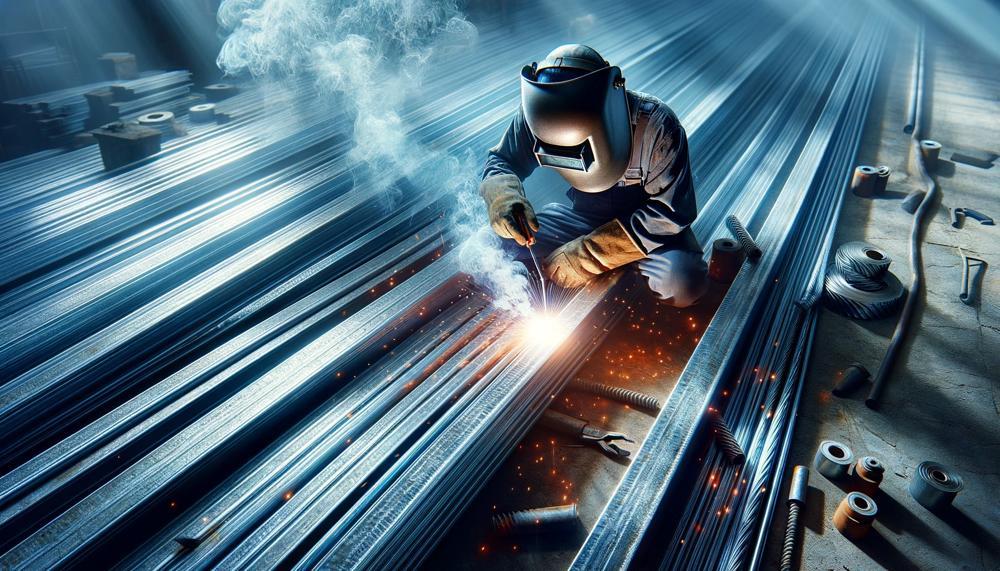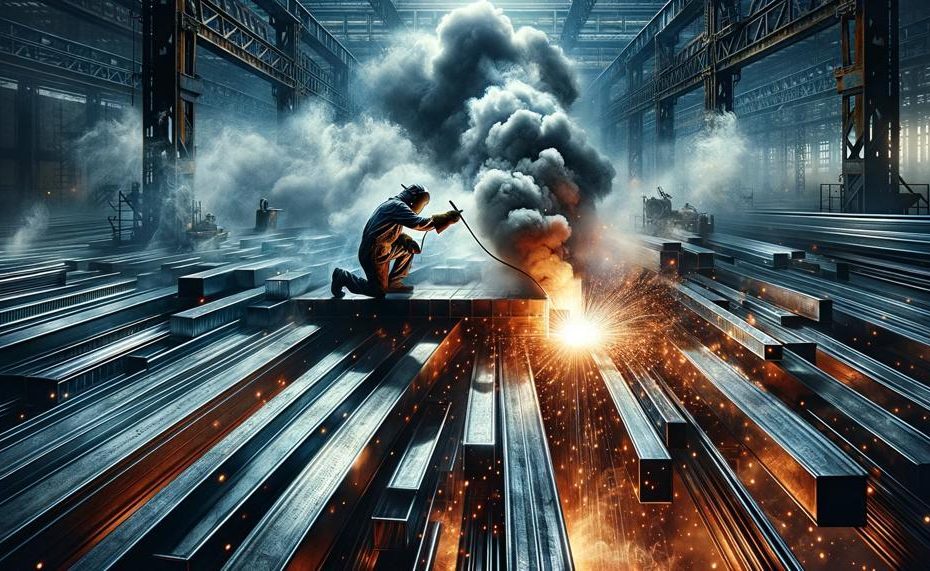It’s a vital process in the world of construction and manufacturing, used to fuse metal pieces together to create strong and durable structures. But what about when it comes to welding galvanized steel? This type of metal is often coated with zinc, which helps protect against rusting. However, this seemingly harmless practice may actually emit toxic fumes that can pose serious health risks.
So, does galvanized steel give off toxic fumes when welding?
Yes, welding galvanized steel can produce toxic fumes. Inhaling zinc oxide fumes from welding can cause metal fume fever (MFF), a flu-like illness. MFF can cause the following symptoms: Fever, Headaches, Nausea, Chest pain, Chills, Cold sweats, Vomiting, Shaking.
In this blog post, we’ll delve into the dangers of welding galvanized steel and explore ways to mitigate the potential hazards for both workers and those around them. From understanding the science behind the fumes to implementing proper safety precautions, we’ll provide valuable insights and tips for anyone working with galvanized steel in a welding setting.
So let’s put on our protective gear and dive into this important topic – because staying informed can mean staying safe when it comes to welding galvanized steel.
Contents
- 1 Does Galvanized Steel Give Off Toxic Fumes When Welding?
- 2 How Galvanization Works
- 3 Potential Hazards of Welding Galvanized Steel
- 4 Understanding Zinc Oxide Fumes
- 5 The Dangers of Carbon Monoxide in Welding Galvanized Steel
- 6 Other Toxic Substances Released When Welding Galvanized Steel
- 7 Preventative Measures to Reduce Exposure to Toxic Fumes
- 8 Conclusion
Does Galvanized Steel Give Off Toxic Fumes When Welding?
When it comes to welding galvanized steel, it is crucial to be aware of the potential health risks associated with the process. Exposure to toxic fumes can not only harm the welder, but also anyone nearby. Therefore, taking necessary precautions is crucial to ensure safety for all.
One of the most important precautions is implementing proper ventilation in the workspace. This can include using exhaust fans or simply opening doors and windows to allow fresh air circulation. In addition, wearing appropriate Personal Protective Equipment (PPE) such as a respirator mask, safety glasses, and gloves is essential to protect against inhaling toxic fumes and minimize skin contact with hazardous substances.
If possible, consider using alternative types of steel that do not require galvanization. This includes stainless steel or aluminum, which can help reduce exposure to toxic fumes. However, if using galvanized steel cannot be avoided, it is recommended to remove the zinc coating before welding to minimize exposure to toxic fumes.
Proper training is also crucial for welders when handling galvanized steel. This includes understanding the process of galvanization and how it affects welding techniques. Maintaining a safe distance from the welding site and ensuring proper storage of galvanized products in a well-ventilated area away from heat and moisture can also help minimize exposure to toxic fumes.
In addition to these precautions, welders should also be aware of the various hazards associated with welding galvanized steel such as intense sparks and splatter, bright light, electrical shock, and carbon monoxide emissions.
How Galvanization Works
Galvanization is a process that involves coating iron or steel objects with a thin layer of zinc. This is commonly done through two methods: hot-dip galvanizing or electro-galvanizing. Both methods offer different benefits and are suitable for different environments.
| Method | Description | Suitable Environments |
| Hot-dip Galvanizing | Dipping metal into molten zinc to create a thicker and more durable coating | Outdoor use, harsh environments |
| Electro-galvanizing | Bonding zinc to metal through electrical current to create a thinner coating | Indoor use, less corrosive environments |
When it comes to galvanization, the process is crucial in protecting metal from corrosion. As a construction worker, I have seen firsthand the effects of corrosion on steel structures. Without proper protection, the wet and salty environment can quickly corrode metal, compromising its strength and longevity.
Fortunately, galvanization offers an effective solution to this problem. By creating a barrier between the metal and its surroundings, it prevents moisture and other corrosive substances from reaching the metal surface. Additionally, the sacrificial anode effect of zinc ensures that even if the coating is damaged, the underlying metal remains protected.
Potential Hazards of Welding Galvanized Steel
| Safety Measures to Avoid Exposure to Toxic Fumes when Welding Galvanized Steel | Description |
| Proper training and certification | Prior to any welding process, it is crucial to receive proper training and certification to handle equipment safely and understand potential hazards associated with welding galvanized steel. |
| Adequate ventilation | Having sufficient ventilation in the work area is essential when welding galvanized steel to dissipate toxic fumes and gases produced during the process. |
| Personal protective equipment (PPE) | Welders should always wear appropriate PPE, including a welding helmet with a shade dark enough to protect their eyes from the bright light of the welding arc. |
| Respiratory protection | In addition to PPE, it is recommended to use respiratory protection such as a respirator or a powered air purifying respirator (PAPR) with suitable filters when welding galvanized steel. |
| Choose the right welding technique | Different welding techniques produce varying levels of fumes and gases. |
Understanding Zinc Oxide Fumes
Zinc oxide fumes are a hazardous byproduct of welding, cutting, or brazing on galvanized metal. Galvanized metal is steel coated with a layer of zinc to prevent rust and corrosion. When this metal is heated during the welding process, it creates zinc oxide fumes.
These toxic fumes can be inhaled by welders and other workers in the vicinity, leading to a condition known as Metal Fume Fever.
| The Danger of Inhaling Zinc Oxide Fumes | Effects on the Human Body | Prevention and Safety Measures |
| Zinc oxide fumes are primarily produced during welding, cutting, or brazing on galvanized metal. | When inhaled, these fumes can cause Metal Fume Fever. This condition is characterized by flu-like symptoms such as fever, chills, coughing, and body aches. In severe cases, it can also lead to respiratory distress and pneumonia. | To prevent exposure to these toxic fumes, welders must receive proper training on handling galvanized metal and using appropriate ventilation systems. Wearing proper personal protective equipment (PPE) is also crucial in preventing inhalation of zinc oxide fumes. Additionally, regular air quality monitoring and adherence to safety protocols are essential in ensuring a safe working environment. |
The inhalation of zinc oxide fumes poses serious health risks for welders and other workers in industries that involve handling galvanized metal. These fumes can have both immediate and long-term effects on the body, making it crucial for welders to take necessary precautions to prevent exposure.
Employers also have a responsibility to provide proper training and equipment to their workers to ensure their safety while working with galvanized metal. By regularly monitoring air quality and following safety protocols, they can prevent exposure and protect their workers from potential health risks associated with zinc oxide fumes.
The Dangers of Carbon Monoxide in Welding Galvanized Steel
Welding galvanized steel can pose a serious health risk, as it produces carbon monoxide fumes that are colorless and odorless. These fumes can cause a range of symptoms, from dizziness and headaches to more severe issues like brain damage and death. This danger is even greater for welders, who are frequently exposed to the welding process. Therefore, it is crucial to be aware of potential health hazards and take necessary precautions to reduce the risk of exposure.
Symptoms of carbon monoxide exposure may appear immediately or hours after exposure. These include dizziness, headaches, nausea, vomiting, confusion, and unconsciousness. It is important for welders to pay attention to their own health and seek medical attention if necessary. Prolonged exposure to high levels of carbon monoxide can lead to permanent brain damage and even death.
To prevent exposure to carbon monoxide fumes, proper ventilation and use of personal protective equipment (PPE) are essential. Employers must provide training on the potential hazards of welding galvanized steel and ensure that workers have the appropriate PPE, such as respirators or air purifying systems. Additionally, regular checks on ventilation systems should be conducted to ensure they are functioning properly.
Other Toxic Substances Released When Welding Galvanized Steel
Welding galvanized steel can release a multitude of toxic substances, such as cadmium, hexavalent chromium, nickel, arsenic, beryllium, and oxides of iron, manganese, and silicon. These substances can cause a range of short-term symptoms, including burning of the eyes and skin, dizziness, nausea, and fever. However, the long-term effects of exposure to these substances can be much more severe, leading to irreversible lung damage.
Cadmium is one such substance that can have detrimental effects on welders. Short-term exposure can result in flu-like symptoms, while long-term exposure can lead to kidney, lung, and bone damage. Similarly, hexavalent chromium can cause skin irritation and ulcers and has been linked to an increased risk of lung cancer. Nickel is known to cause chronic bronchitis and lung irritation, while arsenic can lead to skin irritation and respiratory issues.
Beryllium is particularly dangerous, as it can cause acute lung disease and chronic beryllium disease (CBD), which affects the lungs and lymph nodes.
Furthermore, oxides of iron, manganese, and silicon can cause respiratory irritation and lung damage. Zinc and lead oxide are also hazardous substances that can cause metal fume fever – a temporary flu-like illness with symptoms such as chills, headache, fever, fatigue, and nausea.
To prevent exposure to these toxic substances when welding galvanized steel, it is crucial for welders to take necessary precautions. This includes wearing proper personal protective equipment (PPE), such as respirators, gloves and protective clothing. Moreover, proper ventilation should be in place to prevent the accumulation of fumes in the welding area.
Preventative Measures to Reduce Exposure to Toxic Fumes
Welding with galvanized steel can release harmful fumes that have both short-term and long-term health effects.
To minimize exposure to these toxins, it is crucial to take preventative measures, such as wearing the appropriate personal protective equipment (PPE), ensuring proper ventilation, and utilizing alternative welding methods whenever possible.
Wear Appropriate Personal Protective Equipment (PPE)
When working with galvanized steel, welders must always wear the correct PPE. This includes a respirator, gloves, and eye protection. A respirator specifically designed for welding fumes is necessary to filter out the toxic substances released during the process.
Gloves and eye protection are also essential for shielding the skin and eyes from potential burns or irritation caused by the fumes.
Ensure Adequate Ventilation
Proper ventilation is crucial in reducing exposure to toxic fumes when welding with galvanized steel. Welders should work in well-ventilated areas with fans or exhaust systems to maintain clear air.
Avoid welding in confined spaces or areas with poor air circulation, as this can increase the concentration of fumes in the air.
Explore Alternative Welding Methods
Whenever possible, it is best to use alternative welding methods that do not involve working with galvanized steel. Cold galvanizing or mechanical fastening are two options that do not produce toxic fumes.
If these methods are not feasible, consider using local exhaust ventilation or a fume extraction system to remove fumes from the work area.
Thoroughly Clean the Surface Before Welding

Before welding on galvanized steel, it is crucial to thoroughly clean the surface to remove any zinc coating. The zinc coating contains toxic substances that can be released into the air during welding.
By cleaning the surface beforehand, you can significantly reduce the amount of harmful fumes produced.
Maintain a Safe Distance and Take Breaks
To further minimize exposure to toxic fumes, it is important to maintain a safe distance from the welding fumes and take breaks as needed. Stand at a safe distance from the fumes and avoid breathing them directly.
If you start to feel lightheaded or experience any symptoms of exposure, take a break and step away from the work area.
Conclusion
In conclusion, the seemingly harmless act of welding galvanized steel can actually release toxic fumes that pose serious health risks. These harmful fumes are produced when the intense heat from welding meets the zinc coating on galvanized steel, causing it to vaporize and mix with other chemicals in the air. This can result in immediate symptoms such as nausea and dizziness, as well as long-term consequences like respiratory problems and even cancer.
To mitigate these dangers, it is crucial to take proper safety precautions. This includes ensuring adequate ventilation, using appropriate personal protective equipment, considering alternative types of steel for welding projects, and providing proper training for welders on handling galvanized steel. It is also essential to have a thorough understanding of how galvanization works and the potential hazards associated with welding this type of metal.
By staying informed and implementing necessary safety measures, we can ensure the protection of both workers and those around them from exposure to toxic fumes while welding galvanized steel. Let us prioritize safety in this critical process of construction and manufacturing.





